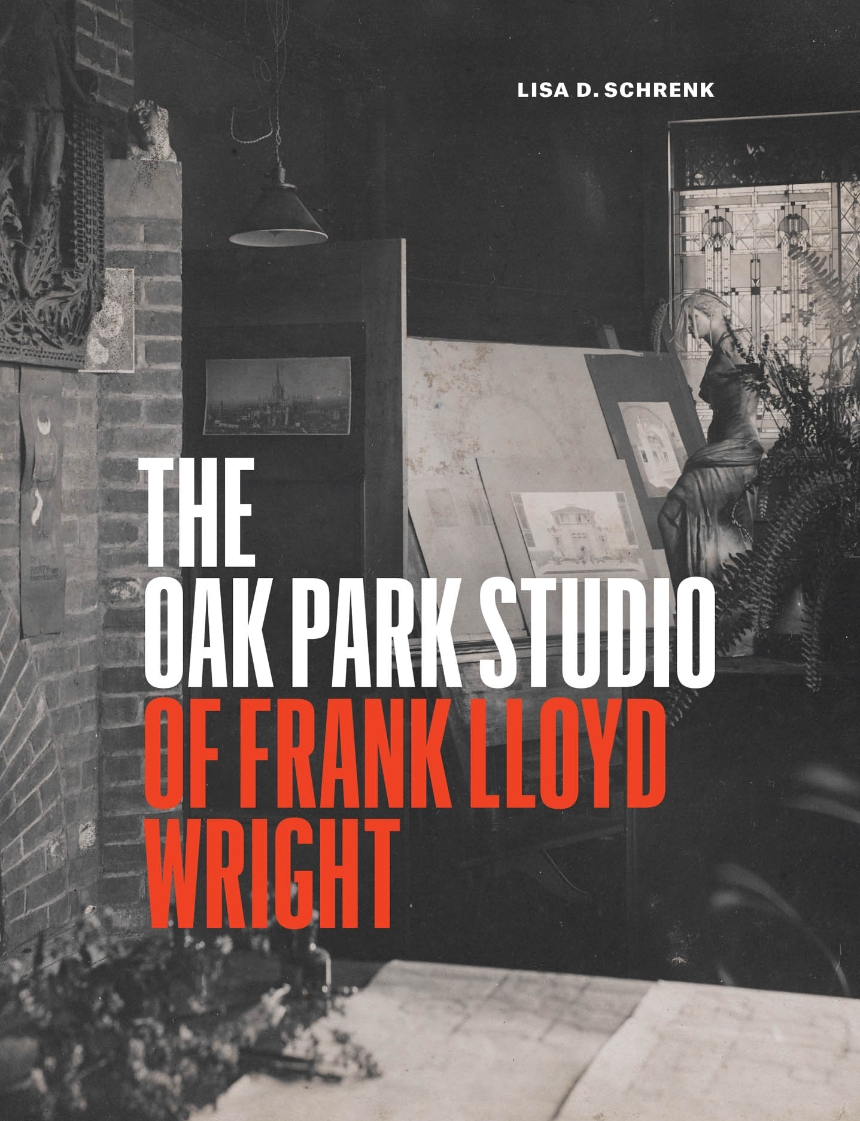The Oak Park Studio of Frank Lloyd Wright
Between 1898 and 1909, Frank Lloyd Wright’s residential studio in the idyllic Chicago suburb of Oak Park served as a nontraditional work setting as he matured into a leader in his field and formulized his iconic design ideology. Here, architectural historian Lisa D. Schrenk breaks the myth of Wright as the lone genius and reveals new insights into his early career.
With a rich narrative voice and meticulous detail, Schrenk tracks the practice’s evolution: addressing how the studio fit into the Chicago-area design scene; identifying other architects working there and their contributions; and exploring how the suburban setting and the nearby presence of Wright’s family influenced office life. Built as an addition to his 1889 shingle-style home, Wright’s studio was a core site for the ideological development of the prairie house, one of the first truly American forms of residential architecture. Schrenk documents the educational atmosphere of Wright’s office in the context of his developing design ideology, revealing three phases as he transitioned from colleague to leader. This heavily illustrated book includes a detailed discussion of the physical changes Wright made to the building and how they informed his architectural thinking and educational practices. Schrenk also addresses the later transformations of the building, including into an art center in the 1930s, its restoration in the 1970s and 80s, and its current use as a historic house museum.
Based on significant original and archival research, including interviews with Wright’s family and others involved in the studio and 180 images, The Oak Park Studio of Frank Lloyd Wright offers the first comprehensive look at the early independent office of one of the world’s most influential architects.
With a rich narrative voice and meticulous detail, Schrenk tracks the practice’s evolution: addressing how the studio fit into the Chicago-area design scene; identifying other architects working there and their contributions; and exploring how the suburban setting and the nearby presence of Wright’s family influenced office life. Built as an addition to his 1889 shingle-style home, Wright’s studio was a core site for the ideological development of the prairie house, one of the first truly American forms of residential architecture. Schrenk documents the educational atmosphere of Wright’s office in the context of his developing design ideology, revealing three phases as he transitioned from colleague to leader. This heavily illustrated book includes a detailed discussion of the physical changes Wright made to the building and how they informed his architectural thinking and educational practices. Schrenk also addresses the later transformations of the building, including into an art center in the 1930s, its restoration in the 1970s and 80s, and its current use as a historic house museum.
Based on significant original and archival research, including interviews with Wright’s family and others involved in the studio and 180 images, The Oak Park Studio of Frank Lloyd Wright offers the first comprehensive look at the early independent office of one of the world’s most influential architects.
336 pages | 179 halftones, 1 table | 8-1/2 x 11 | © 2021
Architecture: American Architecture, History of Architecture
History: American History
Reviews
Table of Contents
Preface
Introduction
1 Roots of the Oak Park Studio: Education and Exploration
2 Opening of the Oak Park Studio (1898): Establishment and Ownership
3 Early Years of the Oak Park Studio (1898–1902): Dialogue and Growth
4 Middle Years of the Oak Park Studio (1903–1905): Opportunity and Diversity
5 Last Years of the Oak Park Studio (1906–1909): Consistency and Change
6 Closing the Studio (1909–1911): Escape and Retrospection
7 Wright’s Further Developments of the Home Studio Concept: Reiteration and Adaption
Conclusion: Legacy of the Oak Park Studio: Dissemination and Manipulation
Epilogue: Evolution of the Home and Studio Post 1911: Division and Renewal
Acknowledgments
Abbreviations
Appendix A: Architectural Designs Carried Out in the Oak Park Studio
Appendix B: Time Line of Architects in the Studio
Appendix C: Biographies of Those Involved in the Oak Park Studio
Appendix D: Letter from Frank Lloyd Wright to Anna Lloyd Wright, 4 July 1910
Appendix E: Text of Sales Brochure for Home and Studio Property
Appendix F: Title Record of Oak Park Home and Studio Property
Notes
Bibliography
Index
Abbreviations
Appendix A: Architectural Designs Carried Out in the Oak Park Studio
Appendix B: Time Line of Architects in the Studio
Appendix C: Biographies of Those Involved in the Oak Park Studio
Appendix D: Letter from Frank Lloyd Wright to Anna Lloyd Wright, 4 July 1910
Appendix E: Text of Sales Brochure for Home and Studio Property
Appendix F: Title Record of Oak Park Home and Studio Property
Notes
Bibliography
Index
